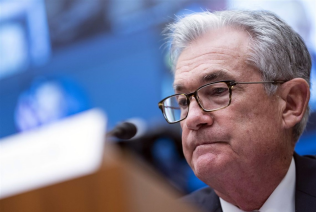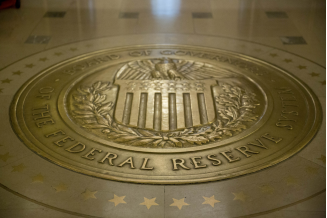Recently, due to differences among Fed policymakers on how to adjust the pace of interest rate hikes after July, the upward trend of the U.S. dollar index has been suspended, and spot gold rebounded slightly to close at $1,865.12 per ounce.
Markets will also be tested by a flurry of key economic data this week. The Fed's favorite inflation gauge, the core PCE price index, will be released on Friday. Although the year-on-year increase in U.S. CPI data in April fell from the previous month, the higher-than-expected high inflation reading still indicates that upward pressure on prices is ingrained. Whether the PCE data will also release a similar signal as the CPI data will affect the Fed's next decision.
The global economy is in turmoil
In recent days, more and more economists are worried that the world is in recession, Europe is suffering from a cost of living crisis, the United States is going from boom to bust, and emerging markets are facing food shortages.
In the past week, in addition to Target and Walmart plunging after earnings reports missed Wall Street's expectations, several other indicators that the U.S. economy is heading for a recession have also emerged.
U.S. household debt hit a record high as rising gasoline and food prices weighed on U.S. consumers. Not only that, but rising mortgage rates are also squeezing the budgets of U.S. consumers, while U.S. businesses large and small face high costs from rising raw materials.
The downturn in the housing market is also holding back the U.S. economy, with U.S. mortgage rates climbing at the fastest pace in nearly four years, and more and more investors believing that the U.S. economy is unlikely to achieve a completely benign soft landing: either the economy weakens, or it falls into decline
Bloomberg Economics last week released the results of a simulation test simulating a long-term reversal of an accelerating globalization trend. The results suggest that the planet will be poorer, productivity will plummet, and trade will return to pre-WTO levels. Also, inflation is likely to be higher and more volatile.
A review of the dollar's "upward path"
On November 30, Powell bowed his head and admitted that inflation is not temporary, and turned the eagle sharply again: it is appropriate to consider ending the reduction in asset purchases several months ahead of schedule. At the December interest rate meeting, the tapering of the bond purchase plan accelerated significantly, and it will end in March 2022. According to the dot plot, 18 committee members believe that interest rates will be raised in 2022, while 12 committee members believe that interest rates will be raised three times.
At the interest rate meeting in January this year, Powell was even more hawkish: the persistence of high inflation is inevitable, emphasizing the policy shift of raising interest rates after the end of QE in March, and does not rule out the possibility of raising interest rates at each meeting. It implies that the market will raise interest rates 4 times (25BP) in 2022.
In March this year, the Federal Reserve officially raised interest rates by 25 basis points, and hinted that it would raise interest rates seven times during the year, with a target interest rate of 1.75% to 2% by the end of the year. In addition, the Fed also made it clear that it will start to shrink its balance sheet as soon as May.
In May of this year, the Federal Reserve raised interest rates by 50 basis points and announced a clear plan to shrink the balance sheet: from June 1, it will shrink the balance sheet at a monthly pace of $47.5 billion, and will gradually increase the limit of the balance sheet reduction to $95 billion per month within three months.
On May 18, Powell said that it is appropriate to continue raising interest rates, and the FOMC broadly supports raising interest rates by 50 basis points each at the next two meetings. Will not hesitate to raise rates above the neutral rate (2%-3%) if necessary. In addition, he also said that no one should doubt the Fed's determination to contain the highest inflation in decades, including raising interest rates above neutral if necessary.
More hawkish and more aggressive each time, the "sharp turn" of the currency opened by the Federal Reserve in this round is unprecedented in the past few decades. Compared with the euro area and Japan, the Fed's monetary tightening is extremely aggressive.
This is one of the very important logics for the continued strength of the US dollar. In the next stage, the Fed will run wildly on the road of monetary tightening. From the current point of view, it is unlikely that the economy will slow down, stop raising interest rates and shrinking the balance sheet because of the subsequent economic weakness or even recession.
Can Europe and Japan rise?
Let's look at the performance of the euro, the largest rival of the US dollar index. On May 11, European Central Bank President Christine Lagarde said at a meeting in Slovenia that the European Central Bank will initially end bond purchases in the third quarter of this year and will decide to raise interest rates within weeks.
On May 18, the ECB was in a hurry. Governing committee Rehn said that inflation expectations must not be allowed to get out of control, and the first interest rate hike may be carried out in the summer. This is a bit more hawkish than the ECB's previous statement. In addition, according to euro zone money market expectations, the possibility of the European Central Bank raising interest rates by 50 basis points in July is about 52%, while the probability of 19th is 44%
This is obviously much slower than the Fed's action, and the Bank of Japan is even more dovish, not raising interest rates. On May 13, Bank of Japan Governor Kuroda Haruhiko reiterated in his speech to the House of Representatives and the Committee on Investigation of Domestic and Foreign Situations that the Bank of Japan would not follow the Fed to tighten monetary policy. As early as April 18 and April 28, Kuroda has reiterated the determination of the Bank of Japan to maintain an easy monetary policy for two consecutive weeks.
The interest rate hikes and magnitudes of the six major monetary sovereign countries anchored by the US dollar are far less than that of the Federal Reserve. This is also an important logic for the substantial strengthening of the US dollar and the weakening of other currencies. In the following, the Fed will continue to substantially raise interest rates and shrink its balance sheet substantially, the logic of the upward movement of the US dollar index has not changed, and the upward trend of gold prices still faces important resistance.
 2022-05-25
2022-05-25
 1320
1320






 简体中文
简体中文
 ภาษาไทย
ภาษาไทย
 繁體中文
繁體中文
 Indonesia
Indonesia











